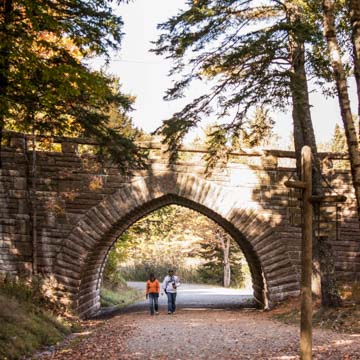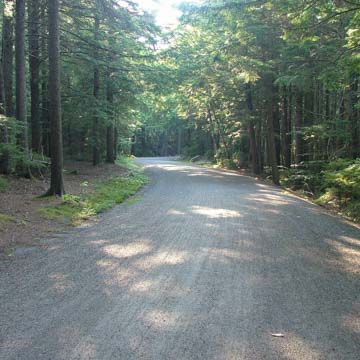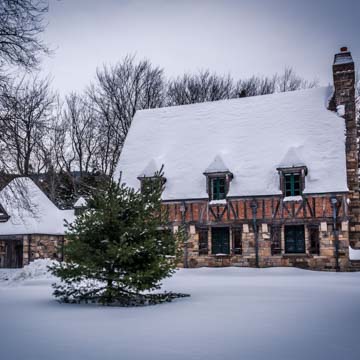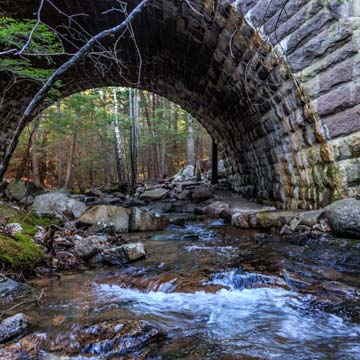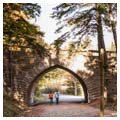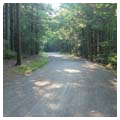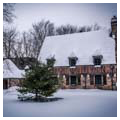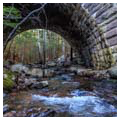The carriage trails, which include 16 bridges, are a unique example of skillful masonry engineering and landscaping. As early as the 1840s Bar Harbor attracted well-to-do tourists and by 1872 had 15 luxury hotels. It was not until the 1890s, Bar Harbor’s “belle epoque,” that the wealthy, including John D. Rockefeller Sr., Andrew Carnegie, Frederick W. Vanderbilt, and Joseph Pulitzer, built their lavish, architect-designed “cottages” overlooking the island-studded Atlantic at places like Southwest Harbor, Northeast Harbor, and Seal Harbor. In 1947 most of these cottages were lost in a forest fire and the carriage trails are in some respects a final vestige of that belle epoque, a vestige, curiously enough, linked to the automobile.
In 1905, urged by the elites who maintained vacation houses in the area, Maine passed legislation barring automobiles from Mount Desert Island. Opposed by local residents, the ban was ultimately rescinded and in 1913 the roads reopened for automobile use. John D. Rockefeller Jr., who had purchased a summer home in Seal Harbor in 1910, conceived of building a system of automobile-free carriage roads on which he and his friends could ride unoffended by noisy and polluting tin lizzies. Between 1913 and 1940, working closely with the recently established National Park Service (NPS), which had dominion over the 15,000-acre Lafayette Park (renamed Acadia National Park in 1929), Rockefeller funded, personally designed (with approval by Frederick Law Olmsted Jr.), and directed the construction of a 57-mile system of landscaped, automobile-free carriage roads winding through the mountains and forests of Mount Desert Island, running inside and outside of the national park (today, 45 miles of roads are located within park boundaries).
Though today John Davidson Rockefeller Jr. is best known as a financier, he was an avid conservationist who saw the carriage road system as a critical means of balancing access to nature with its preservation. Rockefeller learned road building from his father, who taught him to read contours and grade land on the property of their summer home outside of Cleveland, Ohio. After the family moved to New York City, the younger Rockefeller developed a love of carriage driving for sport in Olmsted and Vaux’s Central Park, where the grade separations and orchestrated scenery set a standard for roadbuilding. Growing up in an era of expanding industrialization (to which his father contributed as the co-founder of Standard Oil Company), Rockefeller observed that Americans were living in increasingly urban areas, largely “separated” from nature. Profoundly influenced by the writings of James Fenimore Cooper and Henry David Thoreau, Rockefeller believed that the divine presence revealed itself in nature. He had a particular fascination with wilderness trails, which he felt were literal pathways towards an encounter with natural beauty and this became the foundation of his road-building philosophy. He also studied contemporary road-building techniques in wilderness places, such as Yellowstone National Park, where he traveled on extensive study outings with his friend, Superintendent Horace Albright. The NPS was created, in part, to plan and provide the means of public accessibility to natural areas via roads and facilities. In its early days, the NPS zoned parks as either “wild” (where roads were minimized) or “scenic” (where roads carried tourists to overlooks, waysides, and other facilities built for comfort and enjoyment).
On Mount Desert Island in Down East Maine—where the land was arguably more scenic than wild—owners of summer estates were concerned that private development (much of it generated by their own families and friends) would ruin the very thing they loved about the island: its picturesque beauty. Island cottagers, some of its original “rusticators,” took up the cause of land protection and preservation of natural beauty. Mary Cadwalader Jones, for example, became an advocate for health-oriented island improvements, such as better sanitation systems and water supply inspections. She was also an active member of the Bar Harbor Village Improvement Association, which successfully (if temporarily) banned automobiles from the island and opposed the establishment of an island trolley line. Harvard University president Charles W. Eliot Sr. authored an essay in which he posed an admittedly elitist nightmare scenario of a Coney Island–type development on Mount Desert Island. Eliot, inspired by writings of his landscape architect son, Charles Eliot Jr., who had died in 1897, worked with his fellow cottager and friend George Dorr to form the Hancock County Trustees of Public Reservations to purchase approximately 6,000 acres of island property. Fearful of heavy taxes, the trust transferred their holdings to the NPS; this land later became Acadia National Park.
In an effort to secure substantial financial backing for limited improvements to the land, such as roads and other infrastructure, Eliot invited Rockefeller to visit the island. Enamored of the place, Rockefeller began work on his own Mount Desert Island estate in 1910; here he planned a system of carriage roads reminiscent of those he encountered in his youth. Significantly, however, he proposed extending his roads onto the now public land, securing the permission of the Hancock County Trustees and, later, the NPS.
To plan these carriage roads, Rockefeller personally walked the island, hiking through the forests, around the ponds, and up the mountains, laying out the entire system with careful attention to detail. He decided to limit the roads to the island’s eastern lobe, which had the best views and (at the time) the least population. He took what might be described as a user-based approach to routing the roads, aiming to facilitate the most pleasurable experience for both drivers and horses. He took into account the horse-drivers’ perspective of the rose-colored, glacier-softened mountains as carriages wound around lakes, spruce, and hemlocks. Routes were planned to allow glimpses of the ocean with gradual ascents and gentle curves, to avoid unduly taxing the horses. Painted and stained cedar signposts were spaced to provide directional information to drivers, and at road intersections, he placed triangular patches of trees to provide obvious and logical places where one could pause and consider one’s route.
The roads were built with a crew of 60 laborers plus engineering consultants led by Rockefeller himself. Roads were typically built with a width of 16 feet with three layers of rock: first came the roadbed made of split granite slabs, next was a layer of smaller rocks, and, finally, these were topped with a surface of clay and gravel pressed with a two-ton roller. A road crown of 6 to 8 inches ensured adequate drainage in Maine’s wet climate. Roads were given wide ditches and stone culverts; at curves, they were lined with large, irregularly spaced, odd-angled coping stones that served as guardrails and were popularly referred to as “Rockefeller’s teeth.” To intrude on the landscape as minimally as possible, Rockefeller had his team install retaining walls and breastwalls rather than flatten hillsides at the roadsides.
To carry the roads over streams and chasms, Rockefeller designed 16 steel-reinforced concrete bridges (13 are within the park boundaries). These were faced with cobblestones and intentionally “broken” granite that was hand-quarried on the island. The bridges, all completed between 1919 and 1933, are named according to location or design. Some, like the Small Stone Bridge (1919) over Little Harbor Brook are fairly short (40 feet long); others, like the 140-foot-long, Gothic-arched Deer Brook Bridge or the 238-foot-long “Amphitheater Bridge” (1928), are massive affairs. All have concrete or stone sides clad in quarry-face ashlar and many bear a decorative date stone. Some, like the Duck Brook Bridge, have corbeled, semicircular balconies for rest or observation purposes.
To make good on his pledge to restore the landscape surrounding the roads to its pre-construction appearance, Rockefeller hired leading landscape gardener Beatrix Farrand (daughter of Mary Cadwalader Jones), who was well familiar with the flora of Maine. Though Farrand grew up in New York City, she spent summers with her family at Reef Point Estate on Mount Desert Island. It was on the island that Farrand began to explore gardening as a form of personal expression. Farrand designed several Bar Harbor–area gardens, including Abby Rockefeller’s Mount Desert garden, and eventually settled permanently on the Reef Point Estate. She is perhaps most famous for her design of Dumbarton Oaks in Washington, D.C.
Farrand worked with Rockefeller’s nurseryman to grow thousands of seedlings for use along the carriage roads. Following her own gardening advice to “adapt one’s self to Nature’s key, as she is a lady intolerant of discords,” Farrand chose native species—pine, spruce, birch, maple, ash, blueberries, and sweet fern—that she installed in masses to blend into the surrounding vegetation. This occurred only after she had directed the restoration of disturbed topsoil. Ultimately, Farrand’s work was not only about adding vegetation but also selectively removing it to frame vistas and bridge approaches and arches. Views of ocean and woodland alternated along a given route, providing a varied and dynamic sequence for visitors. Farrand also designed the grounds around two gatehouses that marked carriage road entrances. There, she softened the buildings with plantings of shrubs and climbing vines and blended the grounds into their surroundings with native plants.
These Tudor Revival gatehouses situated at either entrance—Jordan Pond and Brown Mountain—restricted access to the carriage trails. Both were built in 1932 by New York architect Grosvenor Atterbury, who had designed Forest Hills Gardens, New York (begun 1909). For Brown Mountain Gatehouse, Atterbury employed dressed rubble stone in the masonry on the first floor and half-timbering on the upper level. The cypress wood gates are supported by two stone towers. The Jordan Pond Gate House is a two-and-a-half-story structure with a dressed ashlar first story and cypress string courses outlining the half-timbered second story. It has a gabled ell in the rear. The gable roof is steeply pitched, and the half timbers are set vertically with crossbeams and diagonal braces. Atterbury filled the half-timbering with red brick laid in predominately Flemish bond and arranged in a decorative pattern.
Even though only horse-powered vehicles were allowed on the roads, some residents felt that the carriage roads themselves were an intrusion, if not a desecration, of the island’s wildness, and they resented outside visitors entering the pristine inner island. During the planning phase for the carriage roads, Rockefeller and members of the Village Improvement Association (which he refused to join for fear of giving up control over his system) argued over competing visions for the island that were grounded in fundamental differences regarding definitions of the ideal park experience, the interactions of humans and nature, class divisions and relations, and private and public control. Vocal opponents included such figures as U.S. Senator George W. Pepper, a Philadelphian, summer cottager, and avid hiker. Growing tensions convinced the Secretary of the Interior to hold a public hearing on the matter but the outcome was never really in doubt since the Rockefeller influence was too powerful. The cash-strapped NPS accepted a substantial Rockefeller donation and allowed the construction of the roads to continue—even those passing through private properties, which remain private today. After the system was complete, Rockefeller retained ownership of many of the properties that provided access to the carriage roads; in this way, he was able to control vehicular use even though the roads lay primarily on public land.
Around 1940, Rockefeller personally took on maintenance oversight of Farrand’s roadside plantings, which were later almost all destroyed by a 1947 fire. In 1960, after Rockefeller’s death, the NPS took over management of all of the carriage roads, which by then were overgrown and in need of repairs. Combined funds from Friends of Acadia and a Congressional appropriation allowed for the restoration of the system. Today, the carriage roads remain open for non-motorized traffic only, and they are shared by cyclists, hikers, horseback riders, and even horse-drawn carriages. The views and vistas from the carriage roads have been retained.
References
Brown, Jane. Beatrix: The Gardening Life of Beatrix Farrand, 1872–1959. New York: Viking, Penguin Group, 1995.
Bronwyn, Krog, “Carriage Paths, Bridges, Gatehouses, Acadia National Park,” Hancock County, Maine. National Register of Historic Places Inventory-Nomination Form, 1979. National Park Service, U.S. Department of Interior, Washington, D.C.
Goodfellow, Liz. “Beatrix Farrand: private gardens, public landscapes [by] Judith B. Tankard.” Garden History 38, no. 2 (Winter 2010): 322-324.
Haney, David H. “The Legacy of the Picturesque at Mount Desert Island: Controversies over the Development of Acadia National Park.” Journal of Garden History 16 (1996): 275-297.
Hornsby, SJ. “The Gilded Age And The Making Of Bar-Harbor.” Geographical Review 83, no. 4 (1993): 455-68.
Longfellow, Rickie. “Back in Time: Maine’s Carriage Roads.” U.S. Department of Transportation Federal Highway Administration. Accessed March 27, 2019. https://www.fhwa.dot.gov/.
Mattor, Theresa, and Lucie Teegardeb. Designing the Maine Landscape. Camden, ME: Down East Books, 2009.
Moonan, Wendy. “Antiques: Rockefeller's Legacy Of Roads.” New York Times, August 8, 2003.
“Historic Carriage Roads.” National Park Service. Accessed August 27, 2015. www.nps.gov.
Pearson, Carmen. “Introducing the Life and Work of Beatrix Farrand, Landscape Gardener and Writer (1872-1959).” Legacy 25, no. 1 (2008): 128-141.
Rogers, Ann Rockefeller. Mr. Rockefeller's Roads: The Story Behind Acadia's Carriage Roads. Camden, ME: Down East Books, 2012.
Shackel, Paul A. Myth, Memory, and the Making of the American Landscape. Gainesville: University Press of Florida, 2001.
Way, Thaïsa. Unbounded Practice: Women and Landscape Architecture in the Early Twentieth Century. Charlottesville: University of Virginia Press, 2009.






